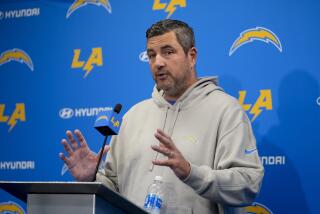Teams use a bunch of ways to test defenses
- Share via
Do good things really come in threes?
Not if you’re an NFL defensive coordinator.
Three-receiver clusters called “bunch” formations are becoming increasingly popular because of the favorable angles and mismatches they create for offenses.
The bunch typically lines up in a triangle, often with the point man at the line of scrimmage. It might be composed of, say, a tight end, a receiver and a running back. At the snap of the ball, the cluster bursts in three directions.
It’s not as if all three players are receivers on any given play. One might stay back and be part of the protection scheme. There’s also a good chance the offense might run out of that formation, especially when the bunch is lined up close to the tight end as opposed to wide.
An offense ideally has created opportunities for short and deep throws, and for the running game.
Often, defenses will adjust by overloading players to the bunch side of the field. That can create one-on-one matchups for the lone receiver on the other side, a favorable situation for any offense.
Most of the time when defenses bring an eighth man into the box, that man is the safety. The bunch formation puts an offense into position to block him.
The most common bunch is three by one -- three players on one side and one on the other -- but another is two and two, which is commonly called “snug.”
“The bunch formation can be effective to stretch a defense both in terms of numbers and angles,” former Baltimore coach Brian Billick said on the NFL Network.
Tampa Bay frequently uses bunch formations when running Jon Gruden’s offense; the New York Jets’ Brett Favre and Pittsburgh’s Ben Roethlisberger frequently use them to their advantage; and every other team has some version of the bunch in its arsenal.
There are advantages and disadvantages to every formation.
But, as many quarterbacks (and cornerbacks) have discovered, an effective bunch can be the most perilous triangle this side of Bermuda.
--
More to Read
Go beyond the scoreboard
Get the latest on L.A.'s teams in the daily Sports Report newsletter.
You may occasionally receive promotional content from the Los Angeles Times.











